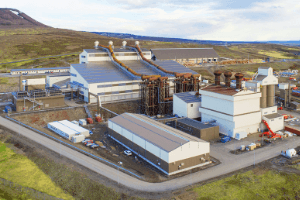We are very familiar with silicones, aluminium alloys and photovoltaic panels. But did you know that all of them contain silicon metal? What is silicon metal? How it is produced? What are its applications? We will answer these questions in our article.

PCC Group has built in Iceland one of the most modern and eco-friendly plant in the world, which produces silicon metal. It was opened in 2018 and in 2019 it started regular production. Silicon metal is used as a component of aluminium alloys or material for the production of silicones and siloxanes in the chemical industry. It is also a key raw material for the production of photovoltaic panels.
Technological process
The plant in Bakki produces silicon metal with a very high content of pure silicon (Si ≥ 98.5%). Raw materials for this production include quartzite (naturally occurring mineral made of silicon dioxide, SiO2), as well as coal and wood. Silicon metal is produced a temperature of approx. 2000C in electric submerged arc furnaces. Quartzite, the key raw material, mainly comes from a Polish mine owned by PCC Silicium SA, which is located in Zagórze near Kielce. The plant in Iceland has special filtration devices, that almost entirely remove dust from the air generated during the production. During the process, two additional products are formed – MicroSilica and silica slag, which are also sold.
During the process, the majority of quartz (SiO 2) is reduced by carbon (C) to silicon carbide (SiC), which is a reducing agent for the remaining part of quartz that has not reacted in the arc electrodes.
The chemical reaction is as follows:
SiO₂ + 2C = Si + 2CO
SiO₂ + 3C = SiC + 2CO (in the lower part of the furnace)
The final reaction takes place above the centre of the furnace at a temperature higher than 1835oC. The electric arc between the electrode tips and the centre of the furnace maintains a temperature of 2000oC.
The final stage of the chemical reaction can be described as follows:
2SiO₂ + 3SiC = 4Si + SiO +3CO
SiO + SiC = 2Si + CO
During this last reaction, pure silicon is formed which is taken out of the furnace in the form of silicon metal.

Figure 1 Simplified diagram of silicon metal production
http://www.pcc.is/the-plant-technology/
Molten silicon metal is extracted from the furnaces to crucibles, which are transferred to the foundry, where the process of refining and ingot casting takes place. After cooling, the ignots are pre-crushed and temporary stored in the furnace area. Then, the product is transferred to the crushing stage and in this form it is packaged for transport.
By-products
One of the products is MicroSilica, which is separated from the flue gas in a special bag filters. Most of the raw material is converted into silicon metal, which results in a very small amount of solid by-products of the production process. A small part of the raw material is processed into slag. All the exhaust gases produced during the production are subjected to further treatment and purification.
Application
Silicon metal, as mentioned above, is a component of aluminium alloys and it is used by the chemical industry for the production of silicones. It is also popular in the electronics industry and the solar energy sector (solar panels, silicon chips, semiconductors). It improves the properties of aluminium, such as strength, hardness or fluidity. The addition of silicon metal makes aluminium alloys strong and lightweight. Silicon metals are also useful in the automotive industry as substitutes for heavier parts made of cast iron. Alloy wheels and engine blocks are the vehicle parts, which are very often produced as aluminium casts with added silicon. Silicon metal is a key raw material for many industries. Without silicon we wouldn’t be able to use computers, solar panels and many construction products. The new PCC plant, which produces silicon metal, uses only green energy from geothermal sources that Iceland is famous for. This allows us to offer the highest quality silicon metal, produced with three times lower carbon dioxide emissions in comparison to other factories.
- Silicon, [w:] PubChem [online], United States National Library of Medicine
- N.N. Greenwood, A. Earnshaw: Chemistry of the elements. Wyd. 2. Oxford: Butterworth-Heinemann, 1997, s. 328–367 (rozdział 9 Silicon)
- "Silicon". Encyclopedia Britannica. Retrieved 22 August 2019